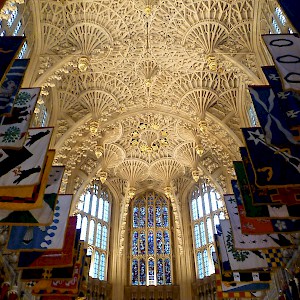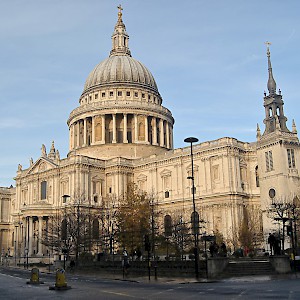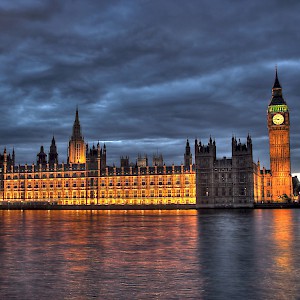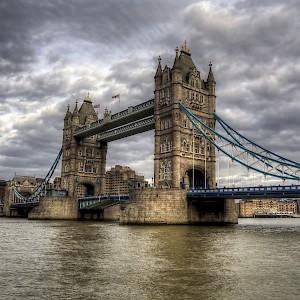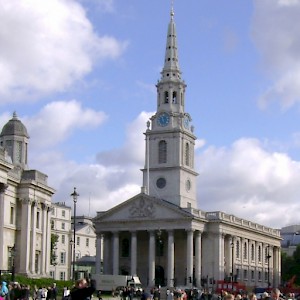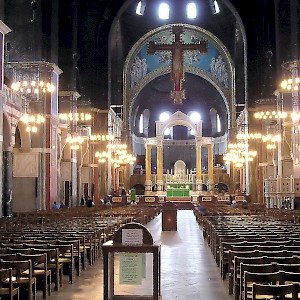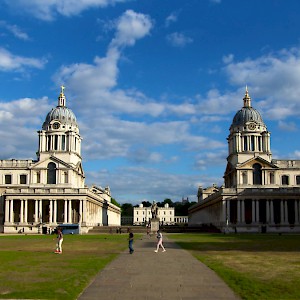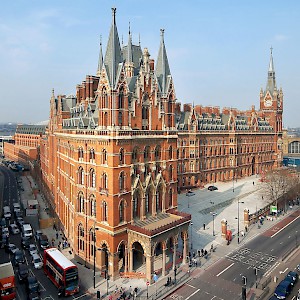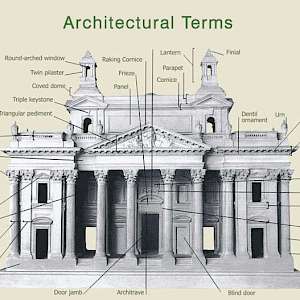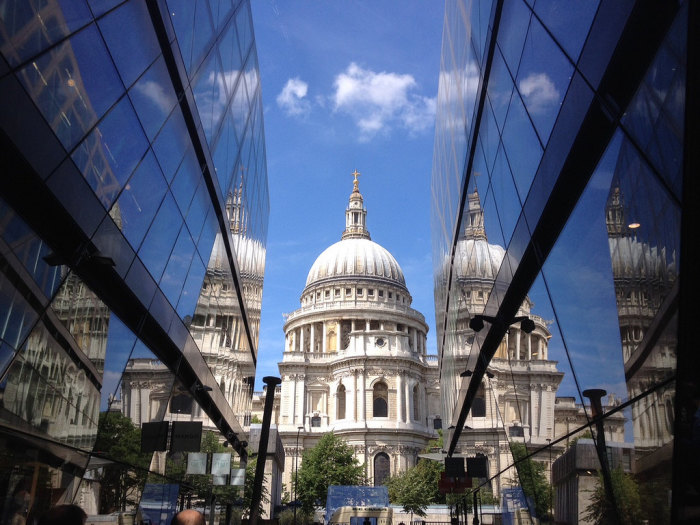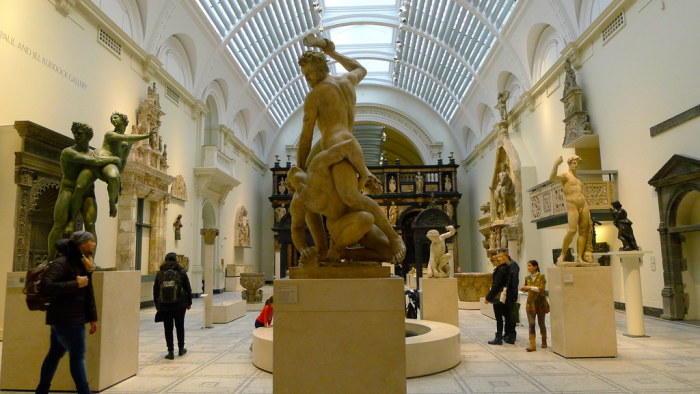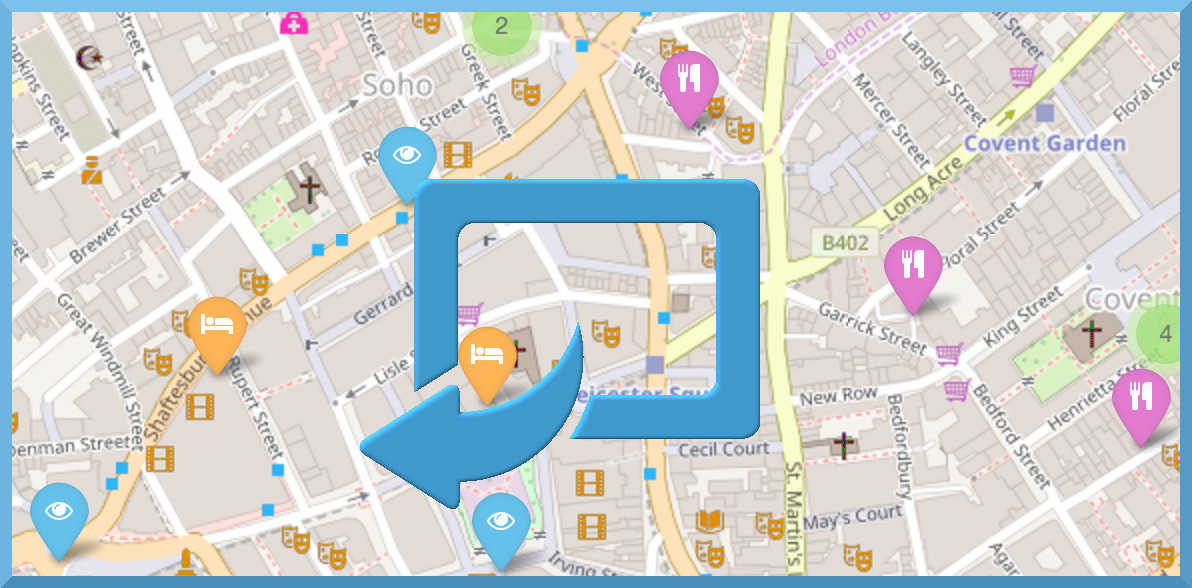Architecture
Sights in London
★★★London's great Gothic abbey is packed with the tombs and monuments of British monarchs and some the world's most famous playwrights, poets, scientists, and other notables
★☆☆London's iconic exclamation point, the clock tower housing Big Ben, sprouts from the honey-hued complex of be-spired 1840 buildings where British Parliament meets (and you can attend sessions)
★☆☆This faux-medieval bridge is well worth the photo stop—but you might not bother with the exhibition
★☆☆London's 18th century church steepling Trafalgar Square hosts excellent free lunchtime concerts with a cheap cafe in the crypt
☆☆☆This London rail station was catapulted to fame as the location of Platform 9 3/4 in the Harry Potter books and movies
☆☆☆London's Catohlic cathedral is notable for free organ concerts and boys' choir—and for NOT being the far more famous Westminster Abbey
☆☆☆Nelson's body lay in state in in Thornhill's impressive Painted Hall of this vast Christopher Wren building in Greenwich
☆☆☆This redbrick Victorian castle is London's prettiest rail station—and home to the Eurostar to the Continent
Topics in England
Why so many British landmarks look medieval but are really about 150 years old
English Architectural History 101: The great eras, styles, and builders of British history
The apogee of British Gothic, all fan vaulting and pointy spires
Architecture Tours3h | from £85
Constantly changing across time, London's topography and architectural elements are completely different from those of any other large European capital. This London Architecture Tour explores the diverse array of influences that have made endowed London with it's strikingly unique cityscape. Walking around the city in the company of our docent, an architectural historian, our discussion will span from the Norman times to cutting edge contemporary structures, offering a general introduction to the main periods and styles of London architecture.
- London Architecture Tour led by an architectural historian
- Small group—6 people max
- See the architectural landmarks of the city
London Architecture Tour
Our walk starts at St. Paul's, jewel of Christopher Wren and ideal start of our excursion (those with an interest in Christopher Wren should also consider our Christopher Wren Churches Tour). From here, we'll proceed to Temple Church, built by the Knights Templar in the 12th century. This church represents one of the best places to discuss Medieval London and the passage from Norman-Romanesque to Gothic architecture. Depending on opening times, we may then visit Prince Henry's Room or the Staple Inn, two of the few examples of Elizabethan and Jacobean timber-framed houses that survived the Great Fire of 1666. We may step inside the Staple Inn to see the great hall, a typical feature of medieval English houses and mansions. For the Jacobean period and the introduction of the Classical architectural language in London, we will then consider Lindsey House on Lincoln's Inn Field, the only surviving example of an ambitious house-building project and one of the first examples of land development in the West End.
Interested in more architecture? Try our Westminster Abbey Tour.
A Changing London
Depending on the day, and the interest of the group, we may circle back to the Square Mile, and discuss the effects of World War 2 on London's urban development. We could consider Brutalism, and the architecture of the Barbican Center, or the role of the City and the financial institutions in reshaping the skyline of London in the past 20 years. Alternatively, we could cross the lively area of Covent Garden and walk through the British Museum, where we will then reach Bloomsbury and, in particular, Bedford Square, one of the finest preserved examples of a mature Georgian square and a typical eighteenth-century attempt to reach perfect symmetry and uniformity in the planning of urban spaces.
Take Aways
At the end of our walk, we'll come away with a deeper understanding of London, its architecture and urban past and future development.
Read more about London's controversial architecture on our blog.
FAQ
Do we go inside the venues or just see them from the outside?
We generally focus on the outside of buildings, but we do occasionally step inside churches or buildings that are relevant to the discussion. No advance tickets are required for these.
What if it’s raining?
Tours operate rain or shine, but in the case of inclement weather, your docent will modify the tour so more time is spent indoors. It never hurts to have an umbrella on hand.
Is this tour good for kids?
Yes! We have some excellent family friendly docents who can appeal to the learning styles of children. Please book privately if you have children under 13. Feel free to provide us with information about your children such as favorite school subjects, and hobbies. This way we can match you with the best possible docent.
Is this a walking intensive tour?
The walk covers about 2 miles, but the exact mileage of the walk depends on the day and the interests of the group.
Where do we start? Where do we end?
We begin near St. Paul's, and end near Bedford Square. Your confirmation email will have the exact meeting point.
3h | from £80
The Victoria and Albert Museum possesses one of the world's greatest collections of decorative art and design in the world, with a collection running the gamut from preparatory materials for the Sistine Chapel to exquisite Islamic art, like the Ardabil Carpet. Our Victoria and Albert Museum Tour, led by a local historian, explores not only the history of the V&A, delving into its origins in the 1851 Great Exhibition, but provides a comprehensive look at a few of the most important galleries in this expansive museum.
- Victoria and Albert Museum Tour led by a design and history expert
- Small group V&A tours—6 people max
- Discover one of the most diverse fine art collections in the world.
Victoria and Albert Museum Tour
After receiving a brief overview of the museum's history outside the building, our tour will continue inside the museum with a visit to the famous Raphael Cartoons (1515-16), which were created by Raphael as preparatory drawings for tapestries intended to hang in the Sistine Chapel (nota bene: for those also headed to Italy, we offer a Vatican Museum Tour), but which today are considered works of art in their own right. Raphael's drawings depict scenes from the lives of St. Peter and St. Paul; we will analyze each in some depth with a discussion of the history of the cartoons, the Renaissance ideals in art, and the relationship between painting and tapestry weaving. We will continue by discussing the history of art and sculpture in the sculpture galleries with works by the Baroque sculptor Bernini, the neoclassical artist Canova, and the late-nineteenth century sculptor Rodin before moving on to the Cast Courts, which contain casts of artworks and objects from around Europe. The collection includes casts of Michelangelo's sixteenth-century 'David', of the first century Trajan's Column, and of the spectacular sixteenth century tomb of St. Sebaldus. Here, we will discuss the Victorian interest in collecting casts.
A Global Collection
From the Cast Court, we'll move to the British Galleries, which chart the changes in British art and design from the Tudor monarchs in the 1500s to Queen Victoria in 1901, in order to consider in greater depth how different styles arose over the centuries and how the social, cultural, and historical contexts influenced these changes. We will focus on a diverse array of objects such as the sixteenth-century 'Great Bed of Ware', the writing box belonging to Henry VIII, the eighteenth-century Rococo music room from Norfolk House, and the Arts and Crafts style as represented by William Morris in the late nineteenth century.
The Islamic Gallery
We will then compare this emphasis on style and design in Western European production with a visit to the Islamic Gallery, where we will focus on the sixteenth-century 'Ardabil carpet' in relation to the function and design of the art object in the Islamic world as well as the tension that developed between art production and science. Here, we will also explore the effects of trade and cultural exchange on design.
Take Aways
Then, depending on time and interest, we can explore the extensive fashion collection (on which we also offer a Victoria and Albert Museum Fashion Tour), visit the exquisite jewelry galleries, or alternatively discuss the form and function of glass over the centuries.
FAQ
What's in the V&A museum?
The Museum’s collections span over 2000 years of human creativity, in virtually every medium and drawn from across Europe, the Middle East, India, China, Japan and many other parts of the world.
Is it true that we can see a replica of the Trajan’s Column?
Yes, the tallest object in the collections is a plaster cast of Trajan’s Column, reproduced from the marble original in Rome. It is displayed in two separate towers which if put together would reach 35.6 m high.
Do we need to pay a ticket to get in?
No, unless you want to see one of the temporary exhibitions, the museum is free. However, donations are greatly appreciated.
4h | from £95
Hop on a train from London to Hampton Court Palace, and visit the most well-known home of infamous Henry VIII. On this Hampton Court Tour, led by a local British historian, we will both appreciate the opulence and historical significance found throughout the grounds. Together, we will inspect the impressive Tudor frontage, the Great Hall, with its remarkable hammer-beam roof, and the huge kitchens that were once used to cook meals for over 1,000 people. We will also be able to see vestiges of several of Henry VIII's six queens, further informing our understanding of the history of the place—Catherine of Aragon’s symbol, the pomegranate, can be seen above a door frame, Jane Seymour’s arms decorate a ceiling, and it is in the Great Watching Chamber that Catherine Howard’s adultery was announced, leading to her execution.
- Hampton Court Tour led by a British History expert.
- Small groups - No more than six people.
- Examines the impressive Hampton Court, as well as the history of Henry VIII and other memorable residents
- Great for families
Hampton Court Tour
On the tour, while we will discuss Henry VIII and the Tudor palace, we will also discover that there is much more to glean about British history by visiting Hampton Court. We'll start our tour by disembarking the train and crossing the River Thames, where we will discuss the importance of the river to monarchs over the centuries. Upon entering the palace, our discussion will move to how, in 1236, the Knights Hospitallers of St. John Jerusalem acquired the Manor of Hampton and used it as a grange, or center, for their agricultural estates before it was leased in 1508 to Cardinal Wolsey, Henry VIII’s Chief Minister. Wolsey carried out vast building works and turned the manor into a magnificent palace; as such, we will discuss both his architectural innovations and his life.
" Our guide's knowledge of history kept us all captivated. It felt like reading a book you didn’t want to put down."
A Royal Residence
In the late 1600s, Hampton Court was adopted by the joint monarchs, William III and Mary II. They hired the great Baroque architect Sir Christopher Wren (the subject of our Christopher Wren Churches Tour) to rebuild the King’s and Queen’s Apartments. We will see the rooms that they used for public ceremonies as well as for private moments. while discussing the functions of these rooms and the daily lives of the monarchs who used them.
Royal Opulence
The Prince and Princess of Wales, the future George II and Queen Caroline, also lived at Hampton Court and redecorated the apartments using fashionable architect and interior designer William Kent. On our travels through the apartments, we will also see great works of art from the Royal Collection, including paintings, precious sixteenth-century tapestries, and the Renaissance masterpiece by Mantegna, "The Triumphs of Caesar."
To The Gardens
Then we will move onward to the gardens, where we will discuss the history from the Tudors to today and wander through the many different areas, from the formal gardens to the orchard, from the 200-year-old Great Vine to the Rose Garden, as well as to the site of Henry VIII’s tiltyard where tournaments were held. At the end, if you still have the energy, you might like to get lost in Hampton Court’s famous maze.
Looking for more royal splendor? Try our Tower of London Tour.
For private tours we can organize a bike excursion to Hampton Court and a lesson of Real Tennis at the Royal Tennis Court. Please ask our office for more info.
FAQ
Where do we meet? Where does it end?
The walk begins at Hampton Court station and ends inside the palace grounds. Your confirmation email will have the exact meeting point details along with a map, and emergency phone number. Hampton Court is very easy to get to by train. South West Trains run direct from London Waterloo to Hampton Court. The journey only takes 35 minutes.
Can I take pictures?
Yes, photography and/or filming is permitted in all areas of the palace with the exception of the Chapel Royal, Royal Pew and Cumberland Art Gallery.
Is this tour good for kids?
Yes! We have some excellent family friendly docents who can appeal to the learning styles of children. Please book privately if you have children under 13. Feel free to provide us with information about your children such as favorite school subjects, and hobbies. This way we can match you with the best possible docent.
Will you pre-purchase tickets?
We pre-purchase tickets to Hampton Court. Your docent will have them on hand.
What if it’s raining?
Tours operate rain or shine, but in the case of inclement weather, your docent will modify the tour so more time is spent indoors. It never hurts to have an umbrella on hand.
Is Hampton Court accessible?
Hampton Court Palace is an historic building and, therefore, has uneven surfaces. We therefore recommend that wheelchair users bring their own wheelchair for comfort and ease. Most of the routes within the palace are accessible to visitors unable to climb stairs as there is a lift to take visitors to the State Apartments on the first floor. Staff and docents will be happy to help. However, many of the staircases are wide and shallow (having been built for William III who was asthmatic).
Is this a walking intensive tour?
The walk is at a leisurely pace. There are occasional opportunities to sit, use the restroom, and get something to drink if needed.
These might include architecture
More tours
Related pages
Sights in London
London's great Gothic abbey is packed with the tombs and monuments of British monarchs and some the world's most famous playwrights, poets, scientists, and other notables
London's iconic exclamation point, the clock tower housing Big Ben, sprouts from the honey-hued complex of be-spired 1840 buildings where British Parliament meets (and you can attend sessions)
This faux-medieval bridge is well worth the photo stop—but you might not bother with the exhibition
London's 18th century church steepling Trafalgar Square hosts excellent free lunchtime concerts with a cheap cafe in the crypt
This London rail station was catapulted to fame as the location of Platform 9 3/4 in the Harry Potter books and movies
London's Catohlic cathedral is notable for free organ concerts and boys' choir—and for NOT being the far more famous Westminster Abbey
Nelson's body lay in state in in Thornhill's impressive Painted Hall of this vast Christopher Wren building in Greenwich
This redbrick Victorian castle is London's prettiest rail station—and home to the Eurostar to the Continent
Topics in England
Why so many British landmarks look medieval but are really about 150 years old
English Architectural History 101: The great eras, styles, and builders of British history
The apogee of British Gothic, all fan vaulting and pointy spires
Constantly changing across time, London's topography and architectural elements are completely different from those of any other large European capital. This London Architecture Tour explores the diverse array of influences that have made endowed London with it's strikingly unique cityscape. Walking around the city in the company of our docent, an architectural historian, our discussion will span from the Norman times to cutting edge contemporary structures, offering a general introduction to the main periods and styles of London architecture.
- London Architecture Tour led by an architectural historian
- Small group—6 people max
- See the architectural landmarks of the city
London Architecture Tour
Our walk starts at St. Paul's, jewel of Christopher Wren and ideal start of our excursion (those with an interest in Christopher Wren should also consider our Christopher Wren Churches Tour). From here, we'll proceed to Temple Church, built by the Knights Templar in the 12th century. This church represents one of the best places to discuss Medieval London and the passage from Norman-Romanesque to Gothic architecture. Depending on opening times, we may then visit Prince Henry's Room or the Staple Inn, two of the few examples of Elizabethan and Jacobean timber-framed houses that survived the Great Fire of 1666. We may step inside the Staple Inn to see the great hall, a typical feature of medieval English houses and mansions. For the Jacobean period and the introduction of the Classical architectural language in London, we will then consider Lindsey House on Lincoln's Inn Field, the only surviving example of an ambitious house-building project and one of the first examples of land development in the West End.
Interested in more architecture? Try our Westminster Abbey Tour.
A Changing London
Depending on the day, and the interest of the group, we may circle back to the Square Mile, and discuss the effects of World War 2 on London's urban development. We could consider Brutalism, and the architecture of the Barbican Center, or the role of the City and the financial institutions in reshaping the skyline of London in the past 20 years. Alternatively, we could cross the lively area of Covent Garden and walk through the British Museum, where we will then reach Bloomsbury and, in particular, Bedford Square, one of the finest preserved examples of a mature Georgian square and a typical eighteenth-century attempt to reach perfect symmetry and uniformity in the planning of urban spaces.
Take Aways
At the end of our walk, we'll come away with a deeper understanding of London, its architecture and urban past and future development.
Read more about London's controversial architecture on our blog.
FAQ
Do we go inside the venues or just see them from the outside?
We generally focus on the outside of buildings, but we do occasionally step inside churches or buildings that are relevant to the discussion. No advance tickets are required for these.
What if it’s raining?
Tours operate rain or shine, but in the case of inclement weather, your docent will modify the tour so more time is spent indoors. It never hurts to have an umbrella on hand.
Is this tour good for kids?
Yes! We have some excellent family friendly docents who can appeal to the learning styles of children. Please book privately if you have children under 13. Feel free to provide us with information about your children such as favorite school subjects, and hobbies. This way we can match you with the best possible docent.
Is this a walking intensive tour?
The walk covers about 2 miles, but the exact mileage of the walk depends on the day and the interests of the group.
Where do we start? Where do we end?
We begin near St. Paul's, and end near Bedford Square. Your confirmation email will have the exact meeting point.
The Victoria and Albert Museum possesses one of the world's greatest collections of decorative art and design in the world, with a collection running the gamut from preparatory materials for the Sistine Chapel to exquisite Islamic art, like the Ardabil Carpet. Our Victoria and Albert Museum Tour, led by a local historian, explores not only the history of the V&A, delving into its origins in the 1851 Great Exhibition, but provides a comprehensive look at a few of the most important galleries in this expansive museum.
- Victoria and Albert Museum Tour led by a design and history expert
- Small group V&A tours—6 people max
- Discover one of the most diverse fine art collections in the world.
Victoria and Albert Museum Tour
After receiving a brief overview of the museum's history outside the building, our tour will continue inside the museum with a visit to the famous Raphael Cartoons (1515-16), which were created by Raphael as preparatory drawings for tapestries intended to hang in the Sistine Chapel (nota bene: for those also headed to Italy, we offer a Vatican Museum Tour), but which today are considered works of art in their own right. Raphael's drawings depict scenes from the lives of St. Peter and St. Paul; we will analyze each in some depth with a discussion of the history of the cartoons, the Renaissance ideals in art, and the relationship between painting and tapestry weaving. We will continue by discussing the history of art and sculpture in the sculpture galleries with works by the Baroque sculptor Bernini, the neoclassical artist Canova, and the late-nineteenth century sculptor Rodin before moving on to the Cast Courts, which contain casts of artworks and objects from around Europe. The collection includes casts of Michelangelo's sixteenth-century 'David', of the first century Trajan's Column, and of the spectacular sixteenth century tomb of St. Sebaldus. Here, we will discuss the Victorian interest in collecting casts.
A Global Collection
From the Cast Court, we'll move to the British Galleries, which chart the changes in British art and design from the Tudor monarchs in the 1500s to Queen Victoria in 1901, in order to consider in greater depth how different styles arose over the centuries and how the social, cultural, and historical contexts influenced these changes. We will focus on a diverse array of objects such as the sixteenth-century 'Great Bed of Ware', the writing box belonging to Henry VIII, the eighteenth-century Rococo music room from Norfolk House, and the Arts and Crafts style as represented by William Morris in the late nineteenth century.
The Islamic Gallery
We will then compare this emphasis on style and design in Western European production with a visit to the Islamic Gallery, where we will focus on the sixteenth-century 'Ardabil carpet' in relation to the function and design of the art object in the Islamic world as well as the tension that developed between art production and science. Here, we will also explore the effects of trade and cultural exchange on design.
Take Aways
Then, depending on time and interest, we can explore the extensive fashion collection (on which we also offer a Victoria and Albert Museum Fashion Tour), visit the exquisite jewelry galleries, or alternatively discuss the form and function of glass over the centuries.
FAQ
What's in the V&A museum?
The Museum’s collections span over 2000 years of human creativity, in virtually every medium and drawn from across Europe, the Middle East, India, China, Japan and many other parts of the world.
Is it true that we can see a replica of the Trajan’s Column?
Yes, the tallest object in the collections is a plaster cast of Trajan’s Column, reproduced from the marble original in Rome. It is displayed in two separate towers which if put together would reach 35.6 m high.
Do we need to pay a ticket to get in?
No, unless you want to see one of the temporary exhibitions, the museum is free. However, donations are greatly appreciated.
Hop on a train from London to Hampton Court Palace, and visit the most well-known home of infamous Henry VIII. On this Hampton Court Tour, led by a local British historian, we will both appreciate the opulence and historical significance found throughout the grounds. Together, we will inspect the impressive Tudor frontage, the Great Hall, with its remarkable hammer-beam roof, and the huge kitchens that were once used to cook meals for over 1,000 people. We will also be able to see vestiges of several of Henry VIII's six queens, further informing our understanding of the history of the place—Catherine of Aragon’s symbol, the pomegranate, can be seen above a door frame, Jane Seymour’s arms decorate a ceiling, and it is in the Great Watching Chamber that Catherine Howard’s adultery was announced, leading to her execution.
- Hampton Court Tour led by a British History expert.
- Small groups - No more than six people.
- Examines the impressive Hampton Court, as well as the history of Henry VIII and other memorable residents
- Great for families
Hampton Court Tour
On the tour, while we will discuss Henry VIII and the Tudor palace, we will also discover that there is much more to glean about British history by visiting Hampton Court. We'll start our tour by disembarking the train and crossing the River Thames, where we will discuss the importance of the river to monarchs over the centuries. Upon entering the palace, our discussion will move to how, in 1236, the Knights Hospitallers of St. John Jerusalem acquired the Manor of Hampton and used it as a grange, or center, for their agricultural estates before it was leased in 1508 to Cardinal Wolsey, Henry VIII’s Chief Minister. Wolsey carried out vast building works and turned the manor into a magnificent palace; as such, we will discuss both his architectural innovations and his life.
" Our guide's knowledge of history kept us all captivated. It felt like reading a book you didn’t want to put down."
A Royal Residence
In the late 1600s, Hampton Court was adopted by the joint monarchs, William III and Mary II. They hired the great Baroque architect Sir Christopher Wren (the subject of our Christopher Wren Churches Tour) to rebuild the King’s and Queen’s Apartments. We will see the rooms that they used for public ceremonies as well as for private moments. while discussing the functions of these rooms and the daily lives of the monarchs who used them.
Royal Opulence
The Prince and Princess of Wales, the future George II and Queen Caroline, also lived at Hampton Court and redecorated the apartments using fashionable architect and interior designer William Kent. On our travels through the apartments, we will also see great works of art from the Royal Collection, including paintings, precious sixteenth-century tapestries, and the Renaissance masterpiece by Mantegna, "The Triumphs of Caesar."
To The Gardens
Then we will move onward to the gardens, where we will discuss the history from the Tudors to today and wander through the many different areas, from the formal gardens to the orchard, from the 200-year-old Great Vine to the Rose Garden, as well as to the site of Henry VIII’s tiltyard where tournaments were held. At the end, if you still have the energy, you might like to get lost in Hampton Court’s famous maze.
Looking for more royal splendor? Try our Tower of London Tour.
For private tours we can organize a bike excursion to Hampton Court and a lesson of Real Tennis at the Royal Tennis Court. Please ask our office for more info.
FAQ
Where do we meet? Where does it end?
The walk begins at Hampton Court station and ends inside the palace grounds. Your confirmation email will have the exact meeting point details along with a map, and emergency phone number. Hampton Court is very easy to get to by train. South West Trains run direct from London Waterloo to Hampton Court. The journey only takes 35 minutes.
Can I take pictures?
Yes, photography and/or filming is permitted in all areas of the palace with the exception of the Chapel Royal, Royal Pew and Cumberland Art Gallery.
Is this tour good for kids?
Yes! We have some excellent family friendly docents who can appeal to the learning styles of children. Please book privately if you have children under 13. Feel free to provide us with information about your children such as favorite school subjects, and hobbies. This way we can match you with the best possible docent.
Will you pre-purchase tickets?
We pre-purchase tickets to Hampton Court. Your docent will have them on hand.
What if it’s raining?
Tours operate rain or shine, but in the case of inclement weather, your docent will modify the tour so more time is spent indoors. It never hurts to have an umbrella on hand.
Is Hampton Court accessible?
Hampton Court Palace is an historic building and, therefore, has uneven surfaces. We therefore recommend that wheelchair users bring their own wheelchair for comfort and ease. Most of the routes within the palace are accessible to visitors unable to climb stairs as there is a lift to take visitors to the State Apartments on the first floor. Staff and docents will be happy to help. However, many of the staircases are wide and shallow (having been built for William III who was asthmatic).
Is this a walking intensive tour?
The walk is at a leisurely pace. There are occasional opportunities to sit, use the restroom, and get something to drink if needed.

